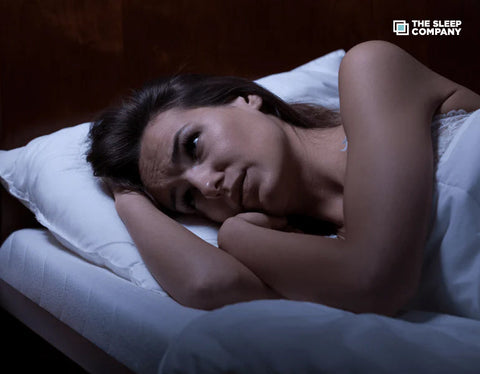My Cart

Top Strategies To Prevent Back Pain While Sleeping


Good sleep is pivotal to your health and overall well-being. The quality of life improves significantly when you ensure quality slumber. Research has revealed that getting insufficient sleep increases your pain threshold.
Back pain is one of the major problems that affect the sleep cycle. Stress or strain from poor posture, uncomfortable sleeping positions, and other lifestyle behaviors are the major factors that cause back pain. Not only does back discomfort make it difficult to get through the day, but it also hampers a restful night’s sleep. It can be challenging to settle into a sleeping position. You can also feel pain when getting in and out of bed.
Try these suggestions to help you sleep a little easier if back discomfort is keeping you from getting adequate rest.
Best Sleeping Positions to Avoid Back Pain

The following sleeping positions are recommended to avoid back discomfort:
- Lay on your side with a pillow between your knees
- Try shifting to your side if laying flat on your back seems uncomfortable.
- Allow the side of your body, including your right or left shoulder, to lie on the mattress.
- Put a pillow in the space between your knees.
You won’t feel better if you sleep on your side by yourself. However, the secret is in how you position the pillow between your knees. Your hips, pelvis, and spine will remain in better alignment thanks to the pillow.
- Lay down in the fetal position on your side.
- Try sleeping on your side curled in a fetal position if you have a herniated disc. Lie on your back and then gradually move over onto your side.
- Gently twist your torso toward your knees while tucking your knees up to your chest.
- Keep in mind to occasionally switch sides to avoid any imbalances.
Your spine’s vertebrae are separated by discs. When a portion of a disc moves outside of its usual space, it herniates, resulting in pain in the nerves, weakness, and other symptoms. The vertebral space can be accessed by curling your torso into the fetal posture.
- Sleep on your stomach with a pillow beneath your stomach.
- Put a pillow beneath your pelvis and lower abdomen to help your back by relieving some of the strain.
- You may or may not decide to put a pillow under your head depending on how comfortable this position is for you.
The benefits of sleeping on your stomach with a pillow may be greatest for people with degenerative disc conditions. Any strain imposed on the area between your discs might be relieved by it
- Lay on your back with a pillow under your knees
- Lie down on your back flat.
- Your knees should be supported by a pillow, and your spine should remain neutral. The cushion is crucial because it helps maintain the curve in your lower back.
- For additional support, you can tuck a small towel that has been tightly coiled under the small of your back.
Your weight is evenly distributed across the largest region of your body when you sleep on your back. You lessen the stress on your pressure points as a result. Additionally, your internal organs and spine can be better aligned.
If you have isthmic spondylolisthesis, sleeping in a reclining position may be advantageous though it may not be the ideal option for back pain. For the finest alignment and support while sleeping in this position, think about investing in an adjustable bed.
Purchase a Quality Mattress

- Make sure your mattress provides you with adequate support so that your spine remains in the position it is in while you are standing.
- Your body type will determine the kind of mattress you require. If your hips are larger than your waist, a soft mattress may be best for you because it will allow your spine to remain straight while you sleep. A harder mattress could feel better because it will provide you with extra support if your hips and waist are already aligned straight.
- To determine which mattress feels the best, try sleeping on a variety of them. Put a piece of plywood between your mattress and box spring or try sleeping on the floor for a few nights if you think a firmer mattress could help. This will help you determine whether the additional support reduces your pain.
- People with lower back discomfort may purchase an orthopedic mattress. It is advisable to consult your doctor before any purchase.
- Next-gen mattresses such as The Sleeping Company’s SmartGRID mattress perfectly adjust to your body shape for mind-blowing comfort and back pain relief.
You can purchase a mattress online or go for offline purchasing. There are many top mattress brands such as The Sleep Company, Sleepy Cat, and Wakefit that offer quality mattresses for back problems.
Selection of Pillow:

- In addition to supporting the top of your spine, a pillow should support your head and neck. Your pillow should entirely enclose the area between your neck and the mattress if you’re sleeping on your back.
- To maintain your head in alignment with the rest of your body when you sleep on your side, try using a thicker pillow.
- For back sleepers, thinner pillows and those with extra cushioning at the bottom to support the neck could be preferable.
- For those who sleep on their stomachs, you should use either no pillow at all or the smallest pillow you can find. You may even try dozing off while holding a body pillow while lying on your side.
- Look for a firm pillow if you want to sleep on your side. Also, remember to tuck a sturdy pillow in between your knees.
- Hybrid pillows ensure that you feel energized every day by providing total support for your head and neck. High-quality comfort is provided by hybrid pillows, such as The Sleeping Company’s SmartGRID Hybrid Pillow
Carefully Enter and Exit the Bed:
Although it may seem apparent, take extra caution when getting in and out of bed. You may experience more back discomfort if you bend forward at the waist or move abruptly. Roll over slowly onto one side, then lift yourself up using your arms. After that, you can slowly get out of bed by swinging your legs out. When it’s time to lie down at night, reverse the motions.
Engage in Exercises:
- Regular exercise is a fantastic method to enhance the quality of your sleep. However, performing specific core-strengthening exercises, which target your abdominal, hip, lower back, and pelvic muscles, can also help relieve back discomfort.
- Yoga or vigorous stretching, according to research, helps lessen low back pain. Additionally, it can improve your sleep and help you feel less stressed.
- Consult your doctor about the types of exercises that are safe for you to perform and which ones won’t make your back discomfort worse.
Medications:
- Some drugs can relieve your back discomfort while also aiding in sleep. They should only be used on your doctor’s advice and as part of a comprehensive treatment plan.
- Short-term use of over-the-counter painkillers such aspirin, acetaminophen, or ibuprofen can be successful.
- Antidepressants like doxepin and duloxetine, medications that have both antidepressant and painkiller effects like amitriptyline, and muscle relaxants like cyclobenzaprine are some examples of prescription medications for back pain.
Reduce Stress:
A major factor causing sleeplessness is stress. Back discomfort is also associated with it. So, try to find techniques to unwind and handle stress better. Practice some relaxing exercises. Try relaxing techniques, and contact your doctor for advice on morning back-supporting activities.
Conclusion
Getting rid of back discomfort is the greatest method to get a decent night’s sleep, but this isn’t always attainable. Although many people tolerate pain, it is frequently preventable and treatable. With the help of the above-mentioned guidelines, you can overcome back pain and attain a good night’s sleep!



































































